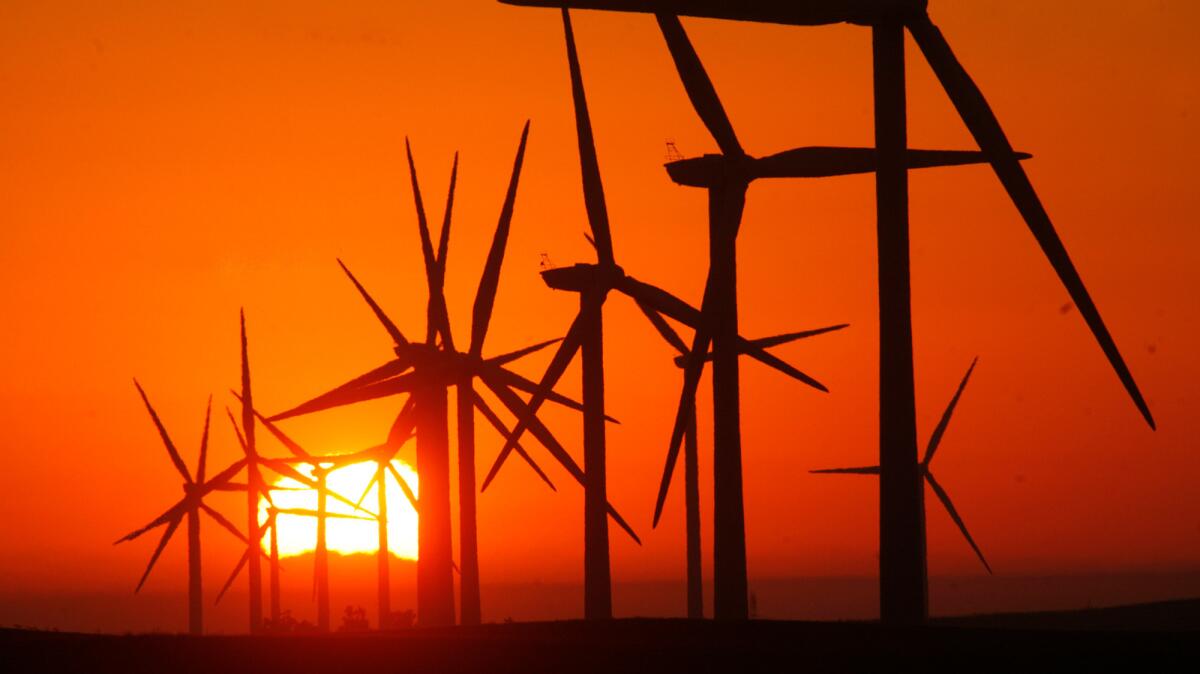Editorial: Whoa. Big grid project moving too fast for comfort

Gov. Jerry Brown doesn’t shy away from big solutions to the problems that ail California. A multibillion-dollar bullet train to transport Californians from north to south. Two giant tunnels beneath the Sacramento-San-Joaquin Delta to help move precious water around the state. The most aggressive climate change laws in the nation.
His latest ambitious undertaking is to build a regional electricity market linking utilities in 11 Western states into a massive electrical grid that could make power more reliable, less expensive and greener. This giant grid would allow California to sell the excess solar power it expects to generate in coming years to states such as Utah to help them kick their coal-burning habits. The big skies over the American West would be clearer and cleaner. Everyone wins, at least that’s the pitch.
It’s a promising idea that energy experts say is the best-option future for the currently power-balkanized West. But this grand plan is still so new that it’s not yet fully thought out — which is a problem because it has been moving forward at breakneck speed despite warnings from environmentalists, legislative leaders and consumer advocates to slow down.
It’s been barely a year since the regional power market idea surfaced in Senate Bill 350, the landmark climate change law mandating that 50% of California’s power come from renewable sources by 2030. Among other things, the bill directed the quasi-governmental agency that manages the flow of electricity through most of the state — the California Independent System Operator, or Cal-ISO — to study the feasibility of developing a regional market for electricity. The study was released this month, showing modest benefits in the form of slightly lower electricity rates and cleaner air. But even before the study was released, pressure was building to get approval for the next step before the Legislature adjourns the session next month.
Whoa. Compared with the glacial movement of most massive government projects, this one is moving at the speed of light. So fast that many people, including some lawmakers, some consumer groups that focus on utilities, and the Sierra Club feel that their questions have been brushed aside by Brown’s energy officials and Cal-ISO. For instance, what does it mean for California to disband Cal-ISO and replace it with a regional commission that would include representatives from states that don’t share California’s strict carbon-reducing goals? Would partnering with the coal-heavy utility PacifiCorp, which serves Utah, Wyoming and other Western states, truly result in that utility reducing its coal portfolio — or would it provide markets and incentives for PacifiCorp to continue producing dirty power, as some fear? Is it possible that municipal utilities such as the Los Angeles Department of Water and Power might be swept into the regional market against their will, as they worry might happen? Are the other states in the region on board with California’s grand plan?
Answers must be forthcoming before the Legislature approves dissolving Cal-ISO and replacing it with a regional board to oversee the new, multi-state grid. A little background: Cal-ISO’s job is to manage the flow of energy through most of California’s high-voltage power lines so that participating utilities have the power where they need it, when they need it. It is nonprofit, independent and designed to be impartial to any of the participants, which include the three large private investor-owned utilities in California — Southern California Edison, San Diego Gas & Electric and Pacific Gas & Electric.
PacifiCorp, which serves much of Utah, and parts of Wyoming, Idaho, Oregon, Washington and California, and which derives about 60% of its power from coal, would be added to the grid under the proposal. But PacifiCorp executives say they will not be able to partner with the California utilities without approval from regulators in the states they serve. And those states have indicated they won’t participate if California runs the operation on its own. Reasonable, but what’s the guarantee that if California gives up some control of its transmission grid it might not end up undermining its own climate change policy? As of yet, there isn’t one.
The big grid idea might ultimately be one of the great legacies of Brown’s fourth and final term. It could be great for air quality and for ratepayers — if it’s done right. But there’s no reason to rush into it. California is still on track to reach the required 50% of renewable power by 2030, though a regional market might make it a cheaper to get there. Other states have already shown interest in joining the regional market once California gets it going.
But there’s every reason to move deliberately, starting with fact that Californians are still skeptical of state lawmakers’ ability to make wise power policy after the disastrous electricity crisis of 2000. Slamming through a proposal that many informed people feel has not been properly vetted won’t improve the public’s trust.
Follow the Opinion section on Twitter @latimesopinion and Facebook
More to Read
A cure for the common opinion
Get thought-provoking perspectives with our weekly newsletter.
You may occasionally receive promotional content from the Los Angeles Times.










